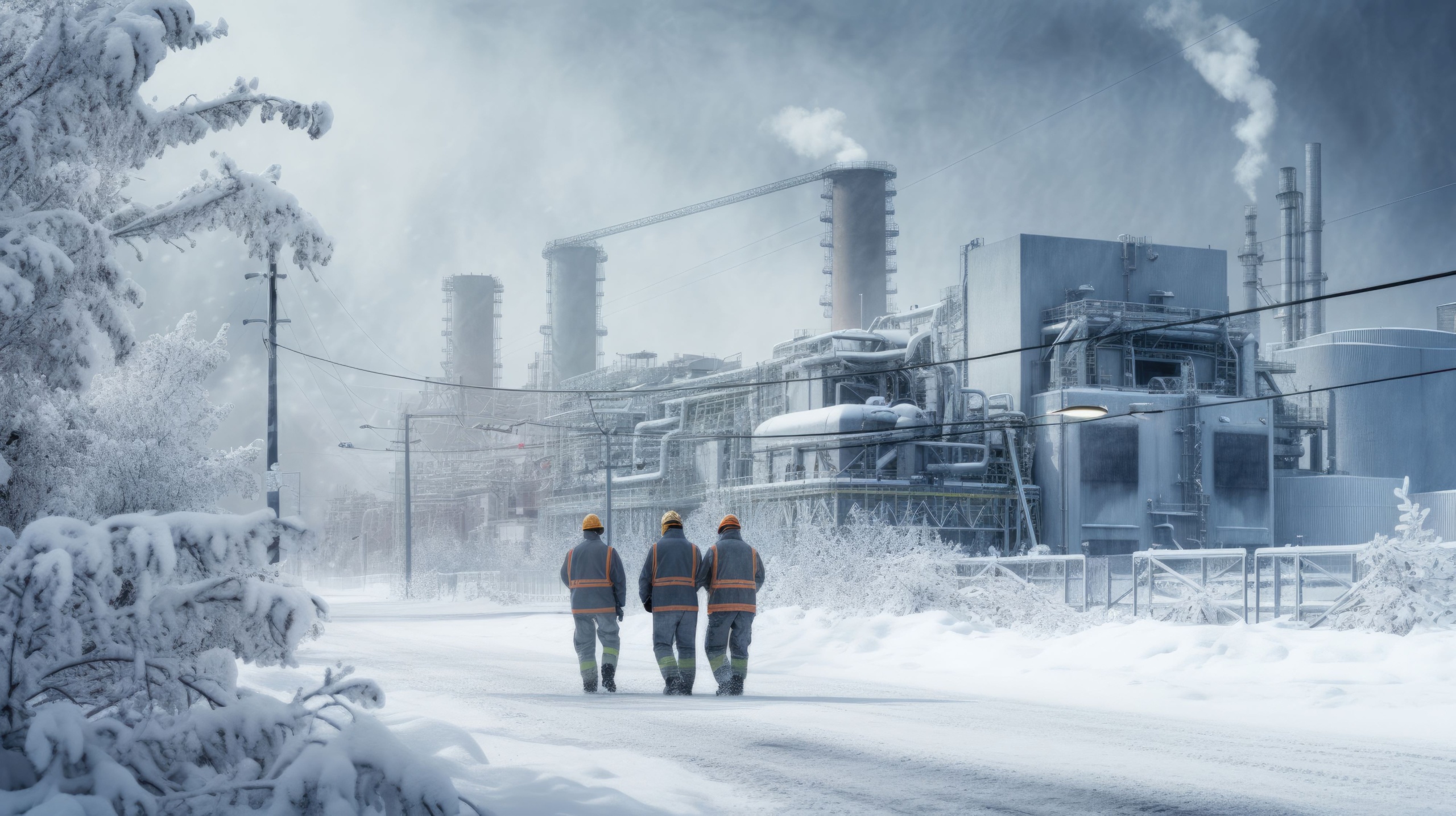Originally posted on: https://ciecka.com/cold-weather-work-hazards-know-your-rights-as-an-employee/
As the winter season unfolds, it brings with it a unique set of challenges for outdoor workers. The plummeting temperatures and harsh weather conditions not only make the work environment uncomfortable but also introduce a range of cold weather work hazards. These hazards are not just limited to the discomfort of working in a cold environment; they pose serious risks of workplace injuries during winter, including frostbite, hypothermia, and other cold stress injuries. It’s imperative for employees working in these conditions, especially in sectors like construction, snow removal, and other outdoor jobs, to be fully aware of their rights and the potential risks. This awareness is crucial not only for personal safety but also for understanding the legal aspects related to workers’ compensation for cold weather-related injuries.
Understanding Cold Weather Work Hazards
The onset of winter brings a significant shift in the working environment, especially for those who work outdoors. Cold weather work hazards are a multifaceted issue that encompasses a range of risks and challenges. One of the primary concerns is the exposure to extremely low temperatures which can lead to cold stress injuries. These injuries are not just limited to the more commonly known conditions like frostbite and hypothermia; they also include less known but equally dangerous conditions such as chilblains and trench foot. These conditions occur when the body loses heat faster than it can produce it, leading to a dangerous drop in body temperature. Outdoor workers, such as those in construction sites or involved in snow removal, are particularly at risk due to prolonged exposure to cold, windy, and often wet conditions.
Another aspect of cold weather work hazards is the impact on operational efficiency and safety. Cold temperatures can make working with machinery and equipment more challenging, increasing the risk of accidents and injuries. Tools and materials can become more difficult to handle, and icy surfaces pose slip and fall hazards. Moreover, wearing bulky protective clothing, although necessary for warmth, can impede mobility and dexterity, further complicating tasks that require precision and care. These factors not only increase the risk of immediate injuries but can also contribute to long-term musculoskeletal problems.
Furthermore, cold weather can exacerbate existing health conditions. Workers with conditions like asthma, Raynaud’s phenomenon, or cardiovascular diseases may find their symptoms worsening in cold conditions. Additionally, the psychological impact of working in a cold environment should not be underestimated. Prolonged exposure to uncomfortable conditions can lead to decreased morale, reduced concentration, and increased fatigue, all of which can indirectly contribute to workplace accidents and injuries. Therefore, understanding these hazards is crucial for both workers and employers to ensure that appropriate measures are in place to mitigate these risks and provide a safe working environment.
Workers’ Compensation and Cold Weather Injuries
Navigating the complexities of workers’ compensation in the context of cold weather injuries is crucial for employees who face the brunt of winter’s harsh conditions. When an employee suffers from injuries like frostbite, hypothermia, or other cold stress-related ailments due to their work environment, they are often eligible for workers’ compensation. This system is designed to provide financial relief for medical expenses and lost wages incurred as a result of workplace injuries. However, the process of claiming these benefits can be intricate and requires a clear understanding of the rights and procedures involved. For instance, proving that the injury is work-related and occurred due to inadequate safety measures or lack of proper equipment can be a critical aspect of the claim.
The role of employers in this scenario is also pivotal. They are required to provide a safe working environment, which includes adequate training and equipment to combat cold weather conditions. Failure to do so can lead to employer liability for winter injuries. This is where the expertise of legal professionals, such as those at Ciecka Law, becomes invaluable. They can guide injured workers through the legal maze, helping them understand their rights and the nuances of filing a successful workers’ compensation claim. This legal assistance is particularly important in cases where there is a dispute about the nature of the injury or the extent of the employer’s liability.
Moreover, the process of claiming workers’ compensation for cold weather injuries is not just about financial restitution; it’s also about ensuring that the injured worker receives the necessary medical treatment and rehabilitation services. This holistic approach is essential for the full recovery of the worker and their eventual return to work. It’s important for employees to be aware of these rights and the support systems available to them, so they can effectively navigate the aftermath of a cold weather work injury. Understanding these aspects ensures that workers are not left to deal with the physical, emotional, and financial burdens of their injuries alone.
Winter Employee Rights and Employer Responsibilities
Winter brings unique challenges to the workplace, particularly for those who work outdoors. It is a time when understanding and respecting winter employee rights and employer responsibilities becomes paramount. Employees have the right to a safe working environment, which is even more critical during the cold months. This includes the provision of appropriate winter safety gear, access to warm shelters, and adequate breaks to prevent cold stress. Employees should also be informed about their rights regarding workers’ compensation in case of cold weather-related injuries. Knowledge about these rights empowers employees to advocate for their safety and seek rightful compensation if they suffer from winter-related workplace injuries such as frostbite or hypothermia.
On the other side of the spectrum, employers have a legal and ethical responsibility to ensure the safety of their workers. This involves adhering to OSHA cold stress standards, which provide guidelines for protecting workers from the hazards of extreme cold. Employers are expected to conduct regular cold weather worksite inspections to identify potential hazards and implement measures to mitigate them. This includes ensuring that the work environment is as warm as possible, providing necessary equipment like anti-slip footwear for icy conditions, and educating employees about the signs of cold stress and the importance of taking regular warm-up breaks. Employers must also understand their liability in cases of winter injuries, as negligence in providing a safe working environment can lead to legal repercussions.
In addition, the winter season demands a proactive approach from employers in terms of emergency preparedness and response. This includes having a clear plan for extreme weather conditions, such as heavy snowfall or blizzards, and ensuring that all employees are aware of and trained in these procedures. Regular training sessions on winter safety, first aid for cold-related injuries, and emergency response can significantly reduce the risk of winter accidents and injuries. By fulfilling these responsibilities, employers not only comply with legal standards but also foster a culture of safety and respect, ultimately leading to a more productive and secure workplace.
Preventing Cold Stress at Work
Preventing cold stress at work is a critical aspect of workplace safety during the winter months. It requires a concerted effort from both employers and employees to ensure that the risks associated with working in cold environments are minimized. For employers, this starts with a thorough risk assessment of the workplace to identify potential cold stress hazards. Based on this assessment, employers should implement appropriate measures such as providing suitable cold weather gear for work, including insulated gloves, hats, and boots, and ensuring that workers have access to warm areas for regular breaks. Additionally, modifying work schedules to avoid the coldest parts of the day and reducing the duration of outdoor tasks can significantly lower the risk of cold stress.
Education and training play a vital role in preventing cold stress at work. Employees should be trained on how to recognize the early signs of cold stress, such as excessive shivering, numbness, and fatigue, and understand the appropriate first aid measures. This training should also cover the importance of wearing proper clothing and layering techniques to maintain body heat while allowing mobility and comfort. Employers should encourage a culture of safety where workers feel comfortable taking breaks when they feel too cold and reporting any symptoms of cold stress without fear of repercussions.
Adapting work practices to the winter conditions is essential. This includes ensuring that safety equipment is winter-proof and functional in cold temperatures, and that work areas are cleared of snow and ice to prevent slips and falls. Employers should also provide warm, sweet beverages to help workers stay hydrated and maintain body temperature and avoid alcoholic beverages as they can increase the risk of hypothermia. By taking these proactive steps, employers can create a safer work environment that significantly reduces the risk of cold stress injuries, ensuring the well-being of their employees during the challenging winter months.
Legal Help for Cold Weather Injuries
When it comes to cold weather injuries at the workplace, personal injury legal assistance plays a crucial role in ensuring that the rights of injured workers are protected and upheld. Navigating the complexities of workers’ compensation claims for cold weather-related injuries can be daunting for many employees. This is where legal experts, particularly those with experience in workplace injury law, become indispensable. The Law Offices of Vincent J. Ciecka, known for our personal injury expertise, can provide invaluable assistance in guiding workers through the legal process. We help in understanding the intricacies of filing claims, ensuring that all necessary documentation and evidence are accurately presented. This includes gathering medical records, witness statements, and expert testimonies to establish the link between the workplace conditions and the injury sustained.
The legal process also involves negotiating with employers and insurance companies, who may be reluctant to acknowledge their liability or may offer inadequate compensation. Experienced attorneys like ours can effectively advocate on behalf of the injured worker, ensuring that they receive fair compensation that covers medical expenses, lost wages, and other damages. This legal support is particularly important in cases where there is a dispute over the cause of the injury or the extent of the employer’s responsibility. Attorneys specializing in cold weather work injuries understand the specific challenges and legal nuances of these cases, making them well-equipped to represent their clients’ interests.
Legal assistance in cases of cold weather injuries is not just about financial compensation; it’s also about ensuring justice and promoting safer workplace practices. By holding employers accountable for unsafe working conditions, legal actions can lead to changes in workplace policies and practices, thereby preventing future injuries. This aspect of legal intervention serves a broader purpose, contributing to the overall improvement of workplace safety standards, especially in industries where employees are vulnerable to harsh weather conditions. In this way, legal help for cold weather injuries extends beyond individual cases, playing a vital role in advocating for worker safety and rights on a larger scale.
Safeguarding Workers in Winter – The Path Forward
As we conclude our exploration of cold weather work hazards and the rights of employees, it becomes evident that the winter season poses significant challenges in the workplace, particularly for those working outdoors. The key takeaway is the importance of awareness and preparedness. Employees must be informed about their rights and the potential risks associated with cold weather, while employers must diligently uphold their responsibilities to provide a safe working environment.
Looking ahead, the collective effort of employers, employees, and legal professionals is essential in creating a safer and more responsive work environment. This involves continuous education, regular safety assessments, and a commitment to adhering to safety standards. By fostering a culture of safety and respect, we can ensure that the rights of workers are protected, and the hazards of cold weather are effectively managed. As we brace for the cold months, let us remember that the well-being of workers is not just a seasonal concern but a year-round commitment. In doing so, we pave the way for a safer, more productive workforce, regardless of the weather challenges that lie ahead.




